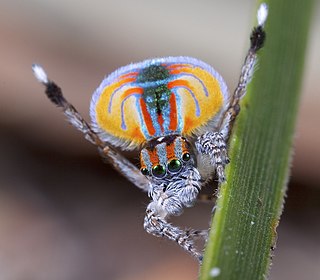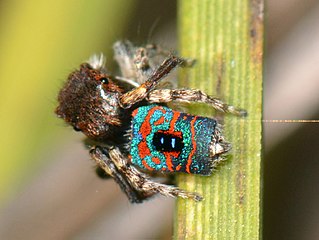
Maratus is a spider genus of the family Salticidae. These spiders are commonly referred to as peacock spiders due to the males' colorful and usually iridescent patterns on the upper surface of the abdomen often enhanced with lateral flaps or bristles, which they display during courtship. Females lack these bright colors, being cryptic in appearance. In at least one species, Maratus vespertilio, the expansion of the flaps also occurs during ritualised contests between males. The male display and courtship dance are complex, involving visual and vibratory signals.

Saitis is a genus of jumping spiders that was first described by Eugène Louis Simon in 1876. The Australian species may belong to other genera, such as Maratus.

Australia has a number of highly venomous spiders, including the Sydney funnel-web spider, its relatives in the family Hexathelidae, and the redback spider, whose bites can be extremely painful and have historically been linked with deaths in medical records. Most Australian spiders do not have venom that is considered to be dangerously toxic. No deaths caused by spider bites in Australia have been substantiated by a coronial inquest since 1979. There are sensationalised news reports regarding Australian spiders that fail to cite evidence. A Field Guide to Spiders of Australia published by CSIRO Publishing in 2017 featuring around 836 species illustrated with photographs of live animals, around 381 genera and 78 families, introduced significant updates to taxonomy from Ramirez, Wheeler and Dmitrov

Peckhamia is a peer-reviewed, open-access, scientific journal covering research on jumping spiders. It is published by the Peckham Society, an international organization of naturalists and scientists with an interest in jumping spiders, named in honor of George and Elizabeth Peckham. The journal was established in 1977 and its current editor-in-chief is David E. Hill.

Maratus speciosus, sometimes called the coastal peacock spider, is an Australian species of jumping spider. They are only known to inhabit the vegetation of the coastal sand dunes of southwestern Western Australia. Like other Maratus spiders, the males of the species engage in a courtship display during which they raise their third pair of legs and their abdomen, presenting their colorful opisthosomal plate to potential female partners. Accompanying their elaborate dance moves, males beat their front and back body halves together, sending vibrations that travel through the ground which the females pick up, stimulating them into receiving higher chances of a successful mate. Unlike other Maratus, however, the males of this species have a set of bright orange hairs (setae) along both edges of the opisthosoma which only become visible during this display. Maratus speciosus derives from the arachnid class with both sexes measuring about 5 mm in body length, equivalent to a pencil eraser. They are known as the smallest species of spiders. This organism is known as diurnal cursorial hunters, meaning they feed on insects. Like any other jumping spider, they rely on their keen vision and jumping actions to help them travel and spot prey at far distances.
Maratus sceletus is a species of the genus Maratus, an Australian member of the jumping spider family. Described in 2015, they have been collected only in Wondul Range National Park in southern Queensland. The species name is derived from the Latin sceletus "skeleton", from its distinctive body pattern. Maratus sceletus is a small species, from 3.7 to 4.7 mm long. The male is black with prominent white stripes and markings across its carapace and legs.

Maratus nigromaculatus is a species of the genus Maratus, an Australian member of the jumping spider family. Described in 1883 by Keyserling as Ergane nigromaculata from a specimen from Rockhampton, they are found in Queensland. The species name is derived from the Latin words niger "black" and maculatus "spotted".

Maratus vespertilio is a species of the genus Maratus, an Australian member of the jumping spider family. Males expand their colorful abdominal flaps for display during courtship as well as in contests with other males.
Maratus albus is a species of the peacock spider genus, characterised by its distinctive courtship display.
Maratus bubo is a species of the peacock spider genus, characterised by its distinctive courtship display.
Maratus lobatus is a species of the peacock spider genus, characterised by its distinctive courtship display.
Maratus tessellatus is a species of the peacock spider genus, characterised by its distinctive courtship display.
Maratus vespa is a species of the peacock spider genus, Maratus, characterised by its distinctive courtship display. The male spiders are characterized by a bright abdomen, lateral flaps, and an elongated third pair of legs. When attempting to attract a mate, the male spider will raise its colorful abdomen and elongated third pair of legs and wave them, along with extending its lateral flaps. This complex display of courtship is analogous of that of a peacock, hence the common name of this spider species.
Maratus harrisi is a species of the genus Maratus, an Australian member of the jumping spider family. It was described in 2011 and is native to the Australian Capital Territory.
Maratus unicup is a species of jumping spider of the genus Maratus.
Saratus is a genus of Australian jumping spiders containing the single species, Saratus hesperus. It was first described by J. C. Otto & D. E. Hill in 2017, and has only been found in Australia. It is placed in the tribe Euophryini of the subfamily Salticinae.

Maratus pavonis is a species of jumping spider (Salticidae), endemic to Australia, where it is found in Western Australia, New South Wales, Victoria and Tasmania. The species epithet, pavonis, derives from the Latin, pavo, pavonis, meaning "peacock".

Maratus mungaich, the banksia peacock spider, is a species of jumping spider in the family Salticidae. It is endemic to Western Australia.

Saitis mutans is a species of spider in the genus Saitis. It is endemic to Australia.












